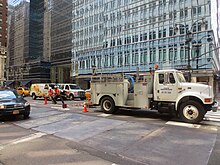Dark fibre
This excess capacity was later referred to as dark fibre following the dot-com crash of the early 2000s that briefly reduced demand for high-speed data transmission.This includes planning and routing, obtaining permissions, creating ducts and channels for the cables, and finally installation and connection.Many fibre-optic cable owners such as railroads and power utilities have always included additional fibres with the intention to lease these to other carriers.Because both ends of the link are controlled by the same organization, dark fibre networks can operate using the latest optical protocols using wavelength division multiplexing to add capacity where needed, and to provide an upgrade path between technologies.Many dark fibre metropolitan area networks use cheap Gigabit Ethernet equipment over CWDM, rather than expensive SONET ring systems.This is typically done using coarse wavelength division multiplexing CWDM because the wider 20 nm spacing of the wavebands makes these systems much less susceptible to interference.
Midtown Manhattanoptical fibrefibre-optic communicationnetwork service providercivil engineeringredundancydot-com bubbletelephone companiescornering the marketgrow exponentiallywavelength-division multiplexingLucent TechnologiesBell Labsdata communicationsbankruptcyGlobal CrossingWorldcomRailway Maniamarket sectorincumbent local exchange carrierscompetitive local exchange carriersunbundled network elementsfibre to the premisescoopetitiontelecoms boombandwidthleased lineInternetInternet infrastructureself-healing ringwavelength division multiplexingmetropolitan area networksGigabit EthernetGoogledata centrespilot signalwavelength multiplexingFiber-optic communicationIndefeasible rights of useSubmarine communications cableArs TechnicaFirst MondayForbesEE TimesSecurities and Exchange CommissionFederal Communications CommissionUSTelecomThe New York Times